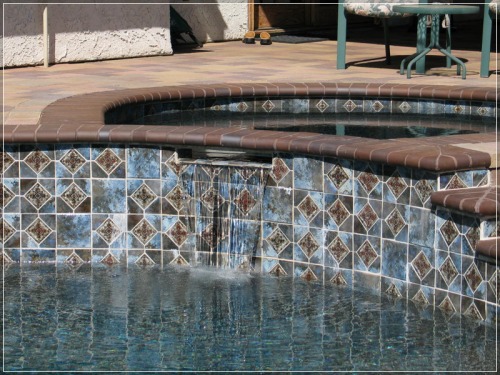Pool tile coping is one of the final steps in constructing a swimming pool. Specifically, coping is the surrounding ledge of a pool that is grabbed onto when someone is swimming or exiting a pool. It certainly provides a nice accent, but there is more to pool tile coping than just looks.
What is the purpose of pool tile coping?
Without tile coping, a concrete block would separate your swimming pool and pool deck. How do you think that would look? Coping prevents water from getting behind the pool shell because it connects with the pool tile. Thus, there is no separation between the tile and the coping.
Additionally, tile coping is ever so slightly slanted. The slight slant forces water from standing on the outer edge by pushing it off the edge and towards the deck drains. Most coping types are porous (absorb water); therefore, it is important to minimize the length of time in which water sits atop the surface.
Pool tile coping also provides grip. There is a reason swimming pool tiles end just beyond the water line and not onto the ledge: Pool tiles are slippery. Coping is made of materials that have traction. So, when someone is standing on the ledge getting ready to do a cannon ball, that person will not slip. Plus, the grip gives each swimmer something to grab onto when they need a break from swimming or floating.
Lastly, we have to revert back to looks. A pool is not always in use, especially in the cooler months. With that being said, it’s nice to have a pool that is easy on the eyes. Swimming pools in general add a nice feature to a back yard, but coping can bring extra attention to it. This thought leads to the various types of pool tile coping.
Types of pool tile coping
Cantilever: Pool deck extends over the edge of the pool and meets with the pool tile. Cantilever coping is not as much about appearance as it is ease of maintenance.
Bullnose brick: Perhaps the most common type of pool tile coping. The ledge juts out an inch or two, making it very easy to grab and grip. Bullnose brick is a nice complimentary look to a swimming pool; however, it does attract heat more so than any other type of coping.
Natural stone: The most appealing type. Natural stone coping is very attractive and can come in materials such as travertine, limestone, and granite. This type of tile coping will likely be more expensive than the others, but it will last for a very long time and will therefore give your pool a beautiful look for a very long time.
Coping and tiling are what stand out in swimming pools. Because of this, it’s important to select your ideal type for each. For your swimming pool needs, Fujiwa Tiles is your top source. We offer over 100 different selections of swimming pool tiles. Our tiles will help give your pool the look you desire. Contact Fujiwa Tiles today! Also, please visit our blog for additional advice and input.
FAQs
- What is pool tile coping?
It refers to the ledge surrounding a swimming pool, which serves both functional and aesthetic purposes. - Why is pool tile coping important?
It prevents water damage, facilitates drainage, provides grip for swimmers, and enhances the pool’s appearance. - What are the different types of pool tile coping?
The main types of pool tile coping include cantilever, bullnose brick, and natural stone, each offering unique advantages in terms of functionality and style. - How do I choose the right pool tile coping for my pool?
Consider factors such as maintenance requirements, aesthetic preferences, and budget when selecting pool tile coping for your pool. - Where can I find high-quality pool tile coping materials?
For a wide selection of premium pool tile coping materials, consider reputable suppliers such as Fujiwa Tiles, offering a range of options to suit your needs.

